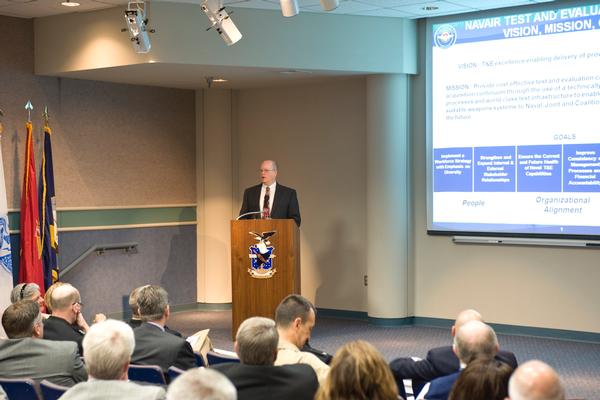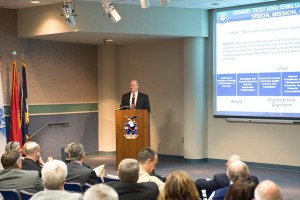Back to the Future


Black Belt Andy Ashenfelter presents the CH-53K Day-in-the-Life Model at Continuous Process Improvement Update Day held Oct. 5. The model identifies the quantity and type of required staffing necessary to meet CH-53K program goals. (U.S. Navy photo)
Using past operational data, NAVAIR expects to improve future business practices.
Through Predictive Modeling, a process of using patterns found in past data to identify potential risks and possibilities, experts can improve resource visibility for projects, translating to faster delivery of products to the fleet.
“Predictive Modeling tells me I have “X” number of resources and how often a particular item is used as it goes through any process,” said Master Black Belt Mike Duncan, director of Continuous Process Improvement for AIR-5.0. “It allows us to take full advantage of the resources we have, which is especially important in today’s budget environment.”
Predictive modeling is not a new concept. Healthcare, insurance and retail companies rely on similar analytical tools to manage and track resources. Predictive Modeling applies the Theory of Constraints and Lean Six Sigma to add and subtract resources to optimize the throughput of a process.
At AIRSpeed’s Continuous Process Improvement Update Day Oct. 5, NAVAIR leadership discussed the value of predictive modeling. That day, the CH-53K program shared its success with predictive modeling to achieve test and evaluation goals.
Using feedback from subject matter experts and past flight test data from Air Test and Evaluation Squadron (HX) 21, Black Belts Andy Ashenfelter and Chas Lin built a model to identify the quantity and type of required staffing necessary to meet program goals.
“We used historical data on the number of months for a flight test period, and number of flight hours of aircraft per month,” said Ashenfelter. “We were able to build the model to compare manpower to flight rate. The model then recommended employee workloads and tracks daily activity to proactively identify bottlenecks or constraints.”
“This model helps us plan for the future,” said Todd Balazs, sponsor for the CH-53K Schedule Optimization and Risk Reduction project and deputy program executive officer for Air ASW, Assault and Special Mission aircraft. “The tool provides us information; in terms of CH-53K, it’s identifying the resources we need well in advance of the aircraft’s arrival.”
“Managers gain visibility of their entire organizations and can avoid delays by allocating the appropriate resources,” said Duncan. “The process isn’t 100 percent accurate and I always tell them (supervisors) they are shooting for 80 percent accuracy. If I give you an 80 percent solution, that’s still better than your best guess.”
A Predictive Model takes several months to build; however, once built, changing inputs, like resources, are simple entries on a spreadsheet.
According to Duncan, demand for this modeling capability across NAVAIR is high, and ought to be expanded. Having a core competency to support this type of analysis would provide consistency between modeling approaches and would allow NAVAIR to better incorporate lessons learned across projects, he added.
“This tool has given us the time necessary to build up the right workforce and inform the program team of the potential constraints that they might have,” said Balazs. “It provides not only benefit to that test team; it provides benefit to the larger NAVAIR.”
For their efforts, the CH-53K Day in the Life Model development team will be honored with a NAWCAD Commander’s Team Award Dec. 7.
Source: NAVAIR























